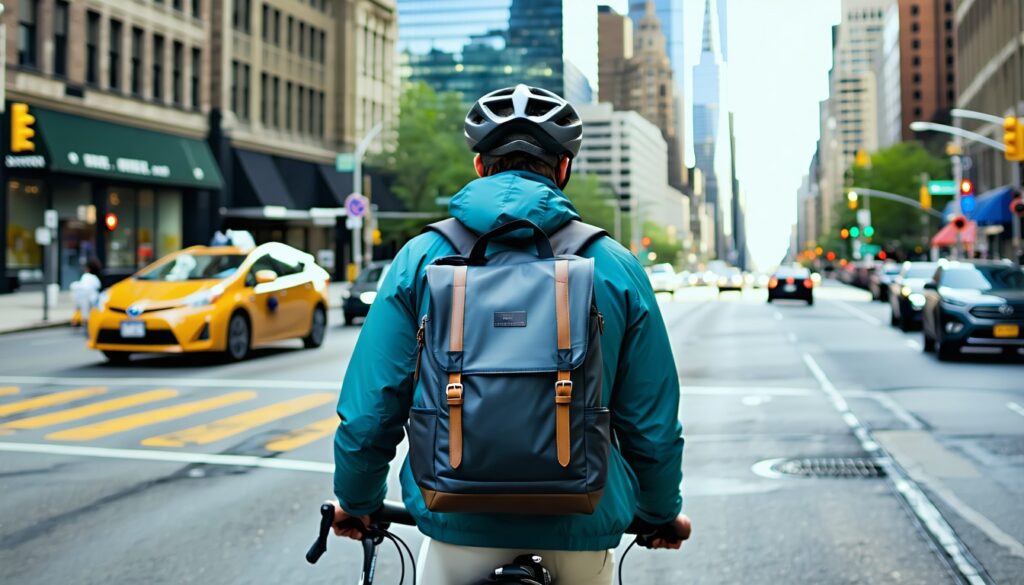How to Secure Your Cycling Backpack While Riding in Traffic

Securing Your Cycling Backpack
When cycling in traffic, it is essential to secure your cycling backpack to prevent theft and ensure ease of access while riding. Here are two effective methods to enhance the security of your cycling backpack.
Locking Zippers for Deterrence
One practical approach to deter theft is to use small luggage locks with a numerical code to lock the zippers together. This method can act as a deterrent, making it harder for thieves to access the contents of the bag. While it may not completely secure the items inside, it directs potential thieves to consider alternatives instead of targeting your bag (Rick Steves’ Europe Travel Forum).
| Lock Type | Benefits | Drawbacks |
|---|---|---|
| Small Luggage Lock | Easy to use; provides a visible security measure | It can be cumbersome to unlock multiple times daily |
Carrying a Backpack in Front:
Another effective strategy is to carry the backpack in front of your body if possible. This is especially advisable when carrying valuable items, such as camera equipment, as it reduces the likelihood of theft. When the backpack is worn on the front, the cyclist can maintain visibility of the bag, making it less of a target for thieves.
Using both the locking zippers and positioning the backpack in front creates a more secure method for cyclists, allowing for a safer ride in traffic. For more tips on efficiently securing a cycling backpack while riding, explore additional methods in our comprehensive articles.
Theft Deterrents for Backpacks
When cycling in traffic, ensuring the security of your backpack is essential. Implementing effective theft deterrents can provide peace of mind while on the road. Here are two common strategies to enhance the security of your cycling backpack.
Strapping a Backpack to Yourself
One effective way to deter theft is to strap the backpack physically to yourself. This method can significantly reduce the likelihood of theft, as potential thieves may be discouraged by the visible attachment to you. Using straps that connect the bag to your waist or chest can provide added security.
| Method | Benefits | Considerations |
|---|---|---|
| Strapping to Self | Reduces theft risk; offers hands-free cycling | May require adjustment for comfort |
| Pannier Bags | Distributes weight; alleviates discomfort | Needs a compatible bike frame |
Using Carabiners for Security
Carabiners, like those used by climbers, can serve as an additional security measure for backpacks. Attaching carabiners to the zippers makes it more challenging for thieves to access your bag discreetly while cycling. This method draws attention if someone attempts to tamper with the zippers, thus acting as a deterrent. Using small luggage locks with a numerical code to secure the zippers can also provide a similar level of protection, although it may be slightly cumbersome to unlock and lock them multiple times a day.
| Security Method | Effectiveness | Ease of Use |
|---|---|---|
| Carabiners | High; makes it difficult to access | Easy to attach but requires manual locking |
| Luggage Locks | Moderate; adds an extra layer | Can be cumbersome for frequent use |
By integrating these theft deterrent methods into your cycling routine, you can enjoy your ride with added security, knowing that your belongings are protected. For more tips on how to secure your cycling backpack while riding in traffic, consider learning about ergonomic features by visiting our guide on how to choose an ergonomic cycling backpack for comfort and posture, and the necessity of ventilation in backpacks, at why a ventilated back panel matters in a cycling backpack.
Features of Cycling Backpacks
When choosing a cycling backpack, several key features play an essential role in ensuring comfort and functionality. Two main aspects to consider are ventilation and fit, as well as the important design elements that enhance usability.
Ventilation and Fit
Ventilation is a crucial factor in cycling backpacks, particularly for those who cycle regularly. A well-ventilated backpack helps to reduce sweat build-up, making for a more comfortable ride. Many cycling backpacks incorporate air channels that promote breathability. This feature allows air to circulate between the backpack and the rider’s back, minimizing overheating during long rides. The Timbuk2 Parker Commuter Backpack exemplifies superior airflow thanks to its center channel and perforated foam padding.
Fit is equally important. A good cycling backpack should not impede the rider’s movement or interfere with their helmet. Adjustable straps, including sternum and hip straps, provide extra stability and keep the backpack securely in place without shifting while cycling. This is essential for comfort, especially on extended rides. When selecting a backpack, look for options that offer both a snug fit and the ability to adjust based on personal preference.
| Feature | Benefits |
|---|---|
| Air Channels | Promotes breathability, reduces sweat |
| Padded Straps | Offers comfort and prevents chafing |
| Adjustable Straps | Ensures a secure fit, enhances stability |
Key Design Elements
Design elements can significantly influence the performance and utility of a cycling backpack. Key features to consider include:
- Multiple Pockets: A well-organized backpack with various compartments helps cyclists store gear, snacks, and tools separately, allowing for easy access on the go.
- Waterproofing: Given the unpredictability of weather conditions, having a waterproof or water-resistant backpack is important to protect contents from rain or splashes.
- Reflective Details: Reflective strips or materials improve visibility, especially during low-light conditions, enhancing safety on the road. The Ortlieb Commuter-Daypack High Visibility features reflective yarn for increased visibility.
- Hydration System: Some cycling backpacks come equipped with hydration systems, allowing riders to stay hydrated without the need to stop.
Selecting a backpack with the right design elements ensures that it meets the unique needs of each cyclist, allowing them to enjoy their rides without worrying about the comfort and safety of their gear. The right backpack can enhance the cycling experience significantly, making it easier to focus on the road ahead while carrying the essentials securely. For more tips on selecting the perfect cycling backpack, check out how to choose an ergonomic cycling backpack for comfort and posture.
Choosing the Right Cycling Backpack
Selecting the appropriate cycling backpack is essential for comfort, practicality, and safety while riding. Here are some factors to consider when making your choice.
Storage Capacity and Balance
The best cycling backpacks are typically designed with a storage capacity between 20 and 30 liters. This range strikes a balance between weight and the space needed for essential items. For those carrying larger items, such as a bike, a 40-liter backpack may be beneficial, allowing for additional support and security through multi-point strapping.
| Backpack Capacity | Ideal For |
|---|---|
| 20-30 liters | Daily commuting |
| 40 liters | Carrying a bike |
Ideal Cycling Backpack Features
When selecting a cycling backpack, key features contribute to overall comfort and usability. Here are some features to look for:
- Air Channels for Breathability: Helps reduce sweat and discomfort during long rides.
- Padded Straps: Offers comfort and prevents strain on your shoulders.
- Chest and Hip Straps: Enhance stability and keep the backpack in place during movement (how sternum and waist straps improve stability on the bike).
- Multiple Pockets: Useful for organization, making it easy to store items like tools, snacks, or electronics.
- Waterproofing: Essential for protecting your belongings from rain.
- Reflective Details: Improves visibility, ensuring safety during low-light conditions.
- Hydration System Compatibility: For cyclists who need to stay hydrated on the go (hydration-compatible cycling backpacks: what to look for).
The Deuter Amager 25+5 backpack is an example of a comfortable and highly water-resistant option, featuring these key elements. Be sure to assess the features that matter most to your cycling style and needs.
Carrying Methods While Cycling
When cycling, the method of carrying belongings is vital for comfort and safety. There are various options available, each with its own set of advantages.
Pannier Bags and Bikepacks
Pannier bags and bikepacks are ideal options for cyclists looking to distribute weight evenly and minimize discomfort. Using pannier bags allows cyclists to attach luggage directly to the bike, keeping the center of gravity low and improving balance. This is especially important during long rides, where uneven weight distribution may lead to fatigue.
Bikepacks, designed specifically for cycling, provide features such as lightweight materials and multiple attachment points. A 40-litre backpack is often recommended for carrying both a bike and necessary gear, offering ample space for essentials while ensuring proper support and distribution.
| Carrying Method | Advantages |
|---|---|
| Pannier Bags | Low center of gravity, reduces fatigue, easy access |
| Bikepacks | Lightweight, customizable, easy to attach |
Avoiding Discomfort and Strain
To avoid discomfort and strain while cycling, it’s crucial to consider ergonomics in both the choice of gear and the method of carrying it. Here are some tips to enhance comfort:
-
Use ergonomic designs: By selecting cycling backpacks that promote good posture, cyclists can prevent back strain during rides. Explore our article on how to choose an ergonomic cycling backpack for comfort and posture for more details.
-
Properly fit straps: Utilizing sternum and waist straps can significantly improve stability. They help keep the backpack secure while cycling, preventing it from shifting and causing imbalance (how sternum and waist straps improve stability on the bike).
-
Ventilation: Select backpacks with a ventilated back panel to promote airflow and prevent overheating. For more insights, read about why a ventilated back panel matters in a cycling backpack.
-
Weight management: It’s important to pack only necessary items and evenly distribute weight within the backpack. This ensures that you maintain balance and control while riding.
By carefully considering how to carry items while cycling, someone can enhance their comfort, maintain focus on the road, and secure their cycling backpack effectively.
Specialized Backpacks for Cycling
When it comes to cycling, the right backpack can make a significant difference in comfort and performance. Specialized backpacks designed for specific activities, such as trail running and mountain biking, offer tailored features to enhance the cycling experience.
Trail Running Backpacks
Trail running backpacks are an excellent choice for cyclists who engage in mountain biking. These backpacks are designed to sit high on the back, allowing for a secure fit while navigating rough terrain. The elevated positioning helps maintain a low center of gravity, making it easier to handle the bike during twists and turns.
Trail running backpacks, like the Mammut MTR 201, are lightweight and crafted for active movement, making them ideal for those who cycle on trails. Here’s a quick comparison of some popular trail running backpacks:
| Backpack Model | Weight (g) | Capacity (L) | Features |
|---|---|---|---|
| Mammut MTR 201 | 400 | 10 | Secure fit, breathable mesh |
| Salomon Advanced Skin | 250 | 12 | Reflective strips, hydration compatible |
| Osprey Dyna | 300 | 15 | Adjustable harness, lightweight design |
These backpacks often include features such as hydration compatibility and reflective strips for visibility, which are crucial for cyclists in traffic.
Considerations for Mountain Biking
When selecting a backpack for mountain biking, several factors come into play to ensure comfort and practicality. Here are key considerations:
- Fit and Stability: A well-fitted backpack prevents bouncing and shifting during rides. Look for options with adjustable straps and a form-fitting design.
- Weight Distribution: Choose a backpack that distributes weight evenly across the back. This helps maintain balance while riding.
- Storage Options: Opt for a backpack that has enough compartments to separate gear, tools, and snacks effectively. Smaller pockets can be handy for storing essentials.
- Breathability: A ventilated back panel is vital for comfort, especially on hot days. To learn more about why a ventilated back panel matters, visit why ventilated back panel matters in a cycling backpack.
Using a specialized backpack designed for mountain biking or trail running enables cyclists to focus on their ride without the hassle of an uncomfortable or poorly fitted bag. Selecting the right gear contributes to a smoother and more enjoyable cycling experience.
Innovative Bike-Carrying Solutions
Cyclists often seek creative methods to transport their gear while ensuring ease of movement and safety. Two innovative bike-carrying solutions include towing gear with a trailer and strapping a bike to a backpack.
Towing Gear with a Trailer
Towing gear behind a bicycle using a trailer is an effective alternative for carrying items while cycling. This method is particularly useful when transporting additional equipment that exceeds what can be comfortably carried on a backpack or the bike’s rack. Trailers come in various sizes and can securely hold camping gear, groceries, or even a child’s bike, allowing for more versatility during rides. This option helps distribute weight evenly and keeps the center of gravity low, promoting stability while navigating traffic or uneven terrains.
| Trailer Type | Capacity (lbs) | Ideal Use |
|---|---|---|
| Single Wheel | 40 – 90 | Light loads and urban commuting |
| Double Wheel | 60 – 120 | Heavy equipment and long-distance touring |
Strapping a Bike to Your Backpack
For some cycling enthusiasts, strapping a bike directly to their backpack is a viable option, especially in scenarios where navigation through tight spaces is necessary. To secure the bike effectively, it is advised to remove both wheels from the bike. The main frame and handlebar should be positioned properly, with the handlebar pointing up, ensuring it is tightly secured. This method minimizes swinging and maintains balance while riding.
| Steps to Strap a Bike to Your Backpack | Tips |
|---|---|
| 1. Remove both wheels | Ensure the bike frame is lightweight |
| 2. Attach wheels securely to the backpack | Use durable straps for stability |
| 3. Position the bike with the handlebars up | Check for balance and adjust as needed |
These innovative solutions offer cyclists alternative methods to manage their gear while riding, enhancing both convenience and safety. For additional insights on how to secure your cycling backpack while riding in traffic, it’s important to consider stability and balance in all carrying methods.
Reviews of Top Cycling Backpacks
Choosing the right cycling backpack is essential for comfort and safety while riding, especially in traffic. Here are reviews of some top cycling backpacks that cater to various needs and preferences.
Timbuk2 Parker Commuter Backpack
The Timbuk2 Parker Commuter Backpack is designed for comfort and functionality. It features a center channel for superior airflow, along with thick perforated foam padding to provide excellent ventilation. This backpack includes both a sternum strap and a waist strap, ensuring it remains secure even when fully packed.
| Feature | Description |
|---|---|
| Ventilation | Center channel with perforated foam |
| Straps | Sternum strap, waist strap |
| Ideal For | Commuters looking for comfort and airflow |
For more details on ergonomic choices, visit How to Choose an ergonomic cycling backpack for comfort and posture.
Ortlieb Commuter-Daypack High Visibility
The Ortlieb Commuter-Daypack High Visibility prioritizes visibility and comfort. It features reflective yarn to improve safety during low-light conditions. The TPU padding ensures exceptional airflow and venting, making it a good option for warm weather commuting.
| Feature | Description |
|---|---|
| Visibility | Reflective yarn |
| Ventilation | TPU padding for airflow |
| Ideal For | Cyclists needing visibility and comfort in warmer weather |
For tips on reflective features for safety, check reflective features that improve cycling visibility.
Chrome Industries BLCKCHRM 22X Yalta 3.0
The Chrome Industries BLCKCHRM 22X Yalta 3.0 excels in organization and waterproofing. It has a ribbed foam back panel for good airflow and a waterproof tote in the main compartment to keep essentials safe from spills. However, the design includes rolltop edges that can obstruct peripheral vision while cycling.
| Feature | Description |
|---|---|
| Airflow | Ribbed foam back panel |
| Organization | Waterproof tote |
| Note | Rolltop design may obfuscate vision |
For ideas on packing strategies, visit how to pack tools snacks and gear in a bike backpack.
Mission Workshop Rhake VX
The Mission Workshop Rhake VX is designed for durability and organization. It features excellent airflow with three padded areas and a Y-styled channel. The front pocket organization allows for easy access to necessities, and it is made of waterproof materials like VX fabric with weatherproof zippers. One downside is that the Fidlock buckles on the pockets can be cumbersome.
| Feature | Description |
|---|---|
| Airflow | Three padded areas |
| Organization | Well-organized pockets |
| Durability | Waterproof materials |
For more insight into waterproofing essentials, check waterproof vs water-resistant: choosing bike-safe backpacks.
Thule Paramount Backpack
The Thule Paramount Backpack offers excellent organization with multiple pockets for gadgets, a laptop sleeve, and designated compartments. Its ribbed, padded foam panels offer limited airflow, and it lacks sternum and waist straps, which may affect stability during longer rides. Despite these drawbacks, it excels in keeping belongings organized.
| Feature | Description |
|---|---|
| Organization | Multiple pockets, laptop sleeve |
| Airflow | Limited with ribbed panels |
| Straps | Lacks sternum and waist straps |
For additional tips on reducing discomfort while riding, visit how to avoid shoulder strain with heavy cycling backpacks.
These backpacks offer a range of features suitable for any cyclist looking for comfort, safety, and organization while cycling. When choosing the right backpack, consider factors like ventilation, visibility, and how it fits into your overall cycling experience.


